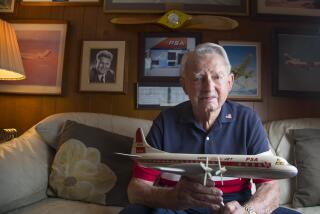PSA Tries Again for the Brass Ring : Carrier Says It’s Poised for Profits After 5 Lean Years
SAN DIEGO — In 1979, one year after airline deregulation, PSA Inc. ordered a batch of new, fuel-efficient DC-9 Super 80s. The move, management boasted, would save operating costs in short-haul markets and successfully position the firm for the competitive 1980s.
Today, halfway into the decade and after hurdling myriad financial and operational obstacles, PSA is taking delivery on new, even more fuel-efficient airplanes.
The move, management insists, will save operating costs in short-haul markets and successfully position the firm to compete in the rough-and-tumble airline industry for the rest of the 1980s.
It hasn’t exactly been a time warp for PSA, but it seems that reality has interfered with management’s growth strategy.
‘Walking Sideways’
“We’ve been walking sideways,” acknowledged Paul C. Barkley, PSA’s 55-year-old president and chief executive, in a recent interview.
So now, after strikes by both airline pilots and air traffic controllers, after a recession and a credit crunch, after a failed attempt to expand in Braniff Airlines’ old Texas market and after approval of an employee profit-sharing plan that cuts wages by 15% and increases production by an equal amount, Barkley believes that the San Diego-based airline is ready to grab the one brass ring that has eluded it this decade: profits.
Pacific Southwest Airlines, the airline subsidiary that accounts for more than 80% of the parent company’s annual revenues, lost nearly $196 million before taxes between 1980 and 1983. The airline has not earned a profit since 1979.
Meanwhile, parent PSA Inc. generated total profits of $51.3 million during that same period, largely because of investment tax credits, depreciation and some profitable operations in other businesses.
Extra Burdens
While all airlines faced the recession, the credit crunch and the traffic controllers strike, PSA, management contends, shouldered extra burdens in the last five years.
A 52-day strike by its pilots in September, 1980, halted flights and gave competitors free rein to swoop in. And the airline staged an unsuccessful bid in 1982 and early 1983 to take over some of failed Braniff International Corp.’s idle Texas routes but were blocked by Braniff’s competitors. The expansion attempt cost PSA about $2 million.
Is the airline’s red ink done with? PSA officials believe that it is, although they stop short of predicting earnings in 1985. Through November, PSA Inc. showed a net income of $1.6 million, so that the company will report “a little profit” in 1984, Barkley said.
Although the airline operations remain unprofitable--to the tune of $12 million through the 11 months ended last November--Barkley insists that it would have made money in 1984 had the new wage-cutting plan been in effect. The new plan could result in savings of as much as $40 million during 1985, Barkley said. Hence the optimism for a return to profitability.
Despite the string of losses, PSA is now completing a five-year, $1-billion fleet overhaul that saw the company sell off its old, gas-guzzling Boeing 727s and buy new McDonnell Douglas Super 80s and BAe 146s (by British Aerospace).
About 38% of the new $1-billion fleet is being leased. Money to finance the balance of the overhaul has been borrowed from Japanese financiers ($180 million), received from a public stock offering ($120 million), secured from investment tax credits from the purchase of the new planes ($120 million), borrowed with a Federal Aviation Administration-guaranteed loan ($100 million), financed by the makers of the new planes ($60 million) and received from the sale of old 727 airplanes ($40 million).
PSA takes delivery of its sixth British Aerospace 146 plane next month, bringing its fleet total to 36, only one more than its total seven years ago. (Deliveries of the plane are about three months behind because of labor problems in England and because PSA modified the plane’s design after it found the seating too cramped and noise levels too high.)
Small-Is-Beautiful Philosophy By year-end, PSA will add 14 more BAe 146s, which the company said operate 26% more efficiently than its 26 Super 80s, 27% more efficiently than its four DC-9-30s (purchased to expand in the Northwest about two years ago) and 42% more efficiently than the old Boeing 727s.
The new plane, the seventh in the company’s 36-year history, reflects a “small-is-beautiful” philosophy, said Barkley. “Finally, hopefully, we’re ready for this brave-new-world stuff.”
Others are not so sure.
“They keep saying they are well positioned, but they are going against a moving target and the industry keeps getting stronger,” according to Dean Witter analyst Jonathan H. Ziegler, who followed PSA from 1979 to mid-1984.
“The question is whether they can keep up with the changes because more airlines are getting favorable labor agreements,” he said. “I’m still not convinced they’ve gotten labor costs low enough, although they had to do what they did.”
One of the few analysts recommending a “buy” on PSA common stock is Greg Kieselmann, director of research with Morgan, Olmstead, Kennedy & Gardner in Los Angeles. Based on money saved from the new labor agreement, he predicts 1985 earnings of $4 per share.
In addition, PSA’s book value, or common stockholders’ net worth, of about $29 per share “well understates real asset value,” Kieselmann claimed. “We think the real book value is about $60 per share.”
Kieselmann said that several valuable pieces of PSA property are fully depreciated--and not reflected on the company’s balance sheet--and the firm’s pension fund has a surplus of about $80 million, which PSA could sink back into the company.
Finally, said Kieselmann, the company and its top executives have been buying PSA stock in the past year--a sign, he said, that the stock is undervalued. PSA has purchased about 700,000 shares of its own stock in the last 12 months, he said.
The stock hit a low of $15 on the New York Stock Exchange last September but closed at $21.75 on Friday.
PSA’s challenges, analysts agree, will come both from competitors and from employees, who will have a 15% stake in the airline’s stock, a 15% share of any airline profits (but no share of the holding company’s earnings) and four seats on the airline’s 13-member board.
Directors who would represent the workers’ interests will assume the new seats, Barkley said, rather than the workers themselves.
Employee Committees
“There is an inherent conflict of interest with workers on the board,” he said. During employee negotiations, for example, “you can’t have a worker making decisions for the shareholders and then taking money away from them during labor talks.”
But, Barkley insists, worker participation will be more than rhetoric.
The company has, for example, offered to pay a search firm to find potential board candidates for the employees. In addition, the company plans to increase its use of employee committees to deal with specific employee problems.
“It won’t be management by committee,” Barkley said, “but there will be quite a change.”
PSA’s advertising will be redesigned to reflect the 3,500 workers’ new role, with the theme “We gotta be tough to make you smile” set to be introduced next Sunday.
The get-tough approach had better be more than show: The airline industry battle in California, already a hot contest, is getting hotter.
“The bigger airlines will be bigger and it will squeeze the medium-sized carriers such as PSA,” according to Tim Pettee, senior investment analyst with L. F. Rothschild, Unterberg, Towbin Inc. in New York.
The so-called California corridor--between airports in the Los Angeles-Orange County area and terminals in the Bay Area--already is one of the world’s most competitive and busiest, and it is “going to get tougher,” Pettee said.
“United Airlines is big (there), and American Airlines has an interest in the West. That may be at the expense of the medium-sized carriers, which have far fewer assets and resources with which to compete.”
PSA figures prominently in the California corridor, what Pettee calls the airline’s “bread-and-butter market.”
According to federal air traffic figures as of June 30 last year, PSA flew 44.5% of the flights in the corridor. Air Cal was second with 31.6%. In addition, 10 airlines compete for about 80 flights between Los Angeles International and San Francisco International airports, twice as many flights and airlines as in 1978.
If Barkley is rankled by the competition, he does his best not to show it.
“We haven’t done badly holding our share,” he said. “Besides, we can’t control who enters the market, (and we can’t) change the industry.”
More to Read
Inside the business of entertainment
The Wide Shot brings you news, analysis and insights on everything from streaming wars to production — and what it all means for the future.
You may occasionally receive promotional content from the Los Angeles Times.









